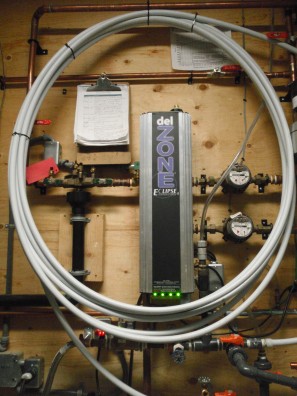Evaluation of Ozone for Residential Rainwater Treatment
Harvesting rainwater for uses that do not require the water to be potable has been practiced for centuries and has recently regained interest as a result of the growing fields of water conservation and low impact development (LID) stormwater management. In a residential setting, harvested rainwater is commonly used for landscape irrigation and outdoor washing. The treatment of rainwater harvested from roofs for uses requiring potable water, such as laundry, showers, dishwashers and drinking water is uncommon in Canada, but has begun in earnest in other parts of the world (e.g. Europe and Australia). While rainwater treatment systems have entered the Canadian water technology marketplace and have been successfully demonstrated in industrial/commercial/institutional buildings (e.g. McMaster University Engineering Technology Building, Hamilton; Boreal Centre for Bird Conservation, Slave Lake), market penetration remains low and applications at the residential-scale are rare.
This project involved integrating ozone and filtration treatment into an existing rainwater harvesting system in the Archetype Sustainable House B at the Living City Campus at Kortright in Vaughan and evaluating its effectiveness to produce potable water. An ozone treatment system was selected, as opposed to more commonly used UV radiation and chlorine systems, due to ozone’s high capacity to disinfect for a range of waterborne pathogens without the need for disinfectant residuals in the produced water, use of fewer consumables, and because system performance can easily be monitored using oxidation-reduction potential (ORP) sensors. The objectives of this study were to:
- Investigate the efficacy and functionality of using a prototype ozone-based treatment system to disinfect rainwater harvested from a residential roof and render the water suitable for potable uses such as drinking, bathing, and dishwashing based on existing Canadian Drinking Water Quality Guidelines.
- Summarize the advantages and disadvantages of ozone disinfection of domestic rainwater, and the conditions under which it is a suitable choice relative to other available options, such as UV radiation and chlorine.
- Suggest potential modifications or alternative designs that would improve its efficacy for residential rainwater treatment.
Roof runoff was directed to a 10,000 L underground rainwater cistern, which was the source water for the treatment system (See Treatment System Schematic). Water samples were measured for oxidation-reduction potential with an ORP sensor, and samples were sent to a laboratory for the quantification of microbiological, nutrient and metal contaminants. These samples were obtained from three different locations throughout the process during three different treatment experiments. The results from the experiments were used to assess the extent to which the ozone-based rainwater treatment system was able to sterilize the cistern water and distribution system, and whether system modifications are necessary.

